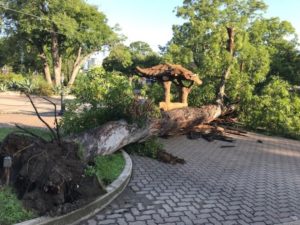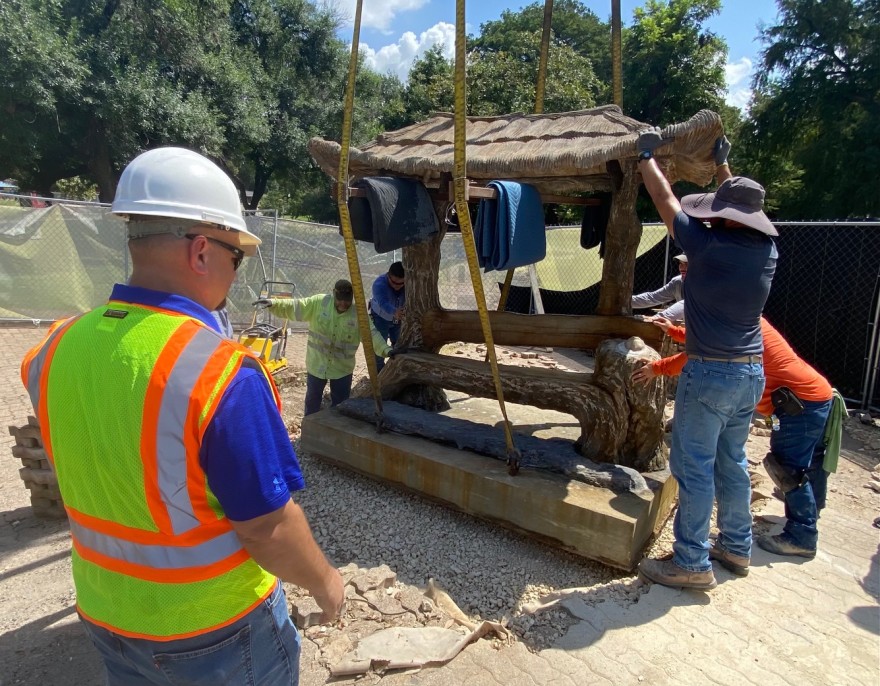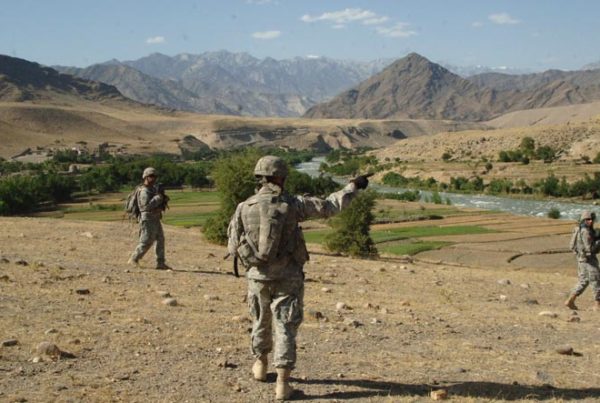Last May, a thunderstorm blew over an aging pecan tree which struck an ornate palapa outside the San Antonio Zoo entrance. The palapa — a small, Mexican beach structure that shelters someone from the rain — was nearly 100 years old.
Soon after the storm, an artist dug it up, then hoisted it with a crane out of the ground and took it to his open air studio for repair.

The fallen pecan tree the morning after, with the grazed roofline of the palapa. Courtesy San Antonio Parks and Recreation
This palapa is big enough for two to sit in, but it’s not made with palm fronds, as they usually are. This one is part of an art form called Trabajo Rústico, an art that Carlos Cortes knows well.
“It is just imitating stone, wood, sometimes steel in concrete,” Cortes said.
Trabajo Rústico is Spanish for “Rustic Work,” and Cortes has created dozens of palapas and other art installations all around town. His family lineage prepared him well for this line of work. Father, artist Maximo Cortes, taught him the art, and his Great Uncle Dionicio Rodriguez is the man who built this recently damaged palapa in the 1920s. Last September, Cortes evaluated the damage.
“The roof is kind of sheared. And it is loose from the supports. So it requires some careful restoration,” he said.
Turns out that restoration job ended up being far more complex than it originally seemed. And the stabilization and repair of the structure wasn’t the toughest part of it.
“I hate to say it’s been almost a year, one more month and it will be a year,” he said. “The hardest part was to get the color to try to look like it hadn’t been repaired.”
A previous repair by another artist had given the palapa an orange-cast stain.
“The person that stained it used an acid stain, which is a lot stronger than mineral salt stain,” he said.
Cortes tried many techniques to remove it, after trial and error finally arrived at a solution. The next fix was how to remake the palapa’s underground base. He settled on a massive concrete rectangle.
“A little bit less than 6 feet by 9 feet, and about 12 inches thick,” Cortes said.
Sticking out of the top of that flat concrete base are four huge steel connectors he concreted into it for easy lifting.
“They’re eye bolts, they can unscrew,” he said. “So we will unscrew them and then pack it with some grease or some wax, something that will preserve it for the future, if anybody wants to move it.”
Cortes has rebuilt this palapa so that those who come afterwards will have a far easier time removing it for repair than he did.
On Monday, Aug. 30, it was finally time to take the palapa back to the zoo. Alamo Crane lowered a rig which was attached to those steel connectors. Tense moments passed as the 15,000-pound palapa and base were lifted, and then set onto the truck bed for transport.
Truck driver Jose Diaz ratcheted tight the chains holding it down. He knew he was transporting something whose value would be hard to calculate.
“If I don’t tie it down or chain it down and it breaks along the way, it’s on me. You gotta be real careful. We gotta take our time with it,” Diaz said. “Hopefully we’ll get it right.”
Cortes said he felt the presence of his long-dead mentors who may have helped him through this long, taxing process.
“I think about my dad and I think about my great uncle quite a bit when I’m working on pieces, especially restoration,” Cortes said. “So I say, please, please, please help me if you can, give me the energy. So I was definitely asking for some favors in the last few days. I think I might have had some help!” he laughed.
Finally, at the zoo, the truck carrying the palapa arrived, and shortly afterward, the truck with the massive crane pulled up. Again the four steel eye bolts were connected, and the palapa was carefully lifted and settled back in its place. Afterwards, Cortes’ sense of relief was palpable.
“I’m just grateful that everything went well, we’re breathing a sigh of relief. Yes, there’s a big weight lifted off my shoulder,” he said.
As this piece of art nears its 100th birthday, baked by the sun, whipped by the wind and rains, and nearly crushed by an enormous pecan tree, an artist’s hand has now brought it back to its former glory.
If you want to see the palapa, it’s on the traffic circle right outside the San Antonio Zoo. And there are now no trees close enough to it, that if they fell, would fall on it.














